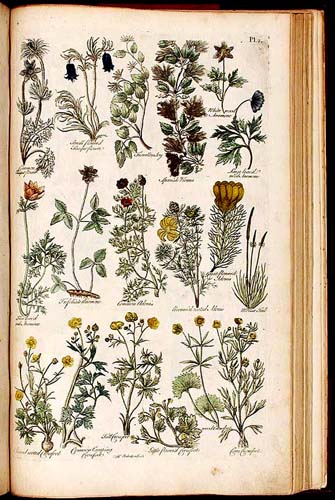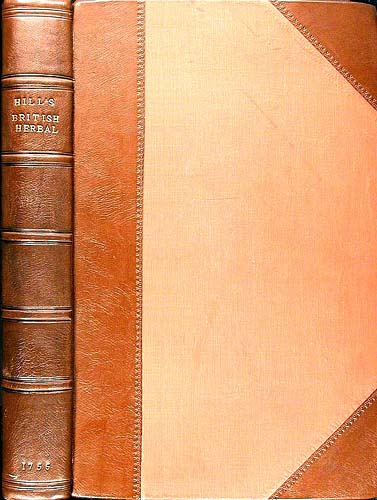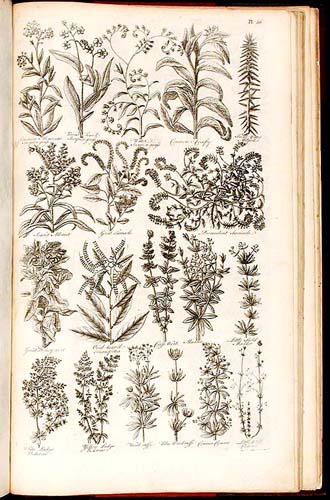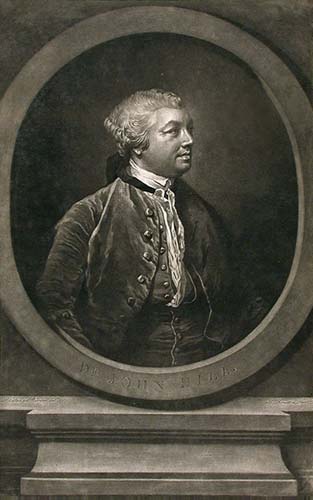cyclopaedia.org

HILL, John (1716?-1775).
The British Herbal: an history of plants and trees, natives of Britain, cultivated for use, or, raised for beauty.
1756 [-1757-1758].
London: T. Osborne, J. Shipton, J. Hodges, J. Newbery, B. Collins, S. Crowder and H. Woodgate
Folio (16 1/2 x 10 1/2 inches). Title printed in red and black with engraved vignette by C. Grignion after S. Wale. Engraved emblematic frontispiece by H. Roberts after Wale, engraved coat-of-arms of the Duke of Northumberland heading the dedication, 74 engraved plates only (of 75) by Benning, Boyce, Roberts and Smith after J. Burgess, plates numbered 2 and 3 with early hand-colouring. (Lacking plate numbered 1).

20th-century half morocco, spine in six compartments with raised bands, lettered in gilt in the second, dated in gilt at the foot of the sixth compartment.


"The genera and species are clearly described in The British herbal, and the work is of importance as being one of the first publications to appear after [Linnaeus'] Species plantarum of 1753, the year internationally accepted as the starting-point for modern botanical nomenclature. A number of generic names used by pre-Linnaean authors, but suppressed by Linnaeus, retain here their first pre-Linnean significance, and were thus restored to botanical nomenclature... The British herbal is also of interest for Hill's criticism of Linnaeus. Although Hill admired and often praised the latter, he did not hesitate to express his opinions when they differed from those of Linnaeus. Many examples of Hill's censures are to be found in The British herbal, and Druce has pointed out that in this work Hill 'criticizes Linnaeus quite fairly and strongly but not with acridity, and shows again and again where that illustrious botanist went wrong'" (Henrey).
Henrey writes of Sir John Hill that "Not only was...[he] industrious and energetic, but his writings show him to have been a man of real ability and genius" (vol. II, p. 91). Unfortunately, he was also conceited, eccentric and fond of self-advertisement: traits not conducive to winning friends, and various false starts in his search for wealth and recognition led him to pursue a number of careers: apothecary, practical botanist, actor, gardener (he apparently assisted in the laying out of a botanic garden in Kew, and was gardener at Kensington Palace) and, most productively of all, miscellaneous writer (the list of his works in the Dictionary of National Biography runs to five and a half columns).

JOHN HILL (c. 1716-1775), called from his Swedish honors, Sir John Hill, English author, son of the Rev. Theophitus lull, is said to have been born in Peterborough in I716. He was apprenticed to an apothecary and on the cornpletion of his apprenticeship he set tip in a small shop in St Martins Lane, Westminster. He also travelled over the country in search of rare herbs, with a view to publishing a hortus siccus, but the plan failed. His first publication was a translation of Theophrastuss History of Stones (1746). From this time forward he was an indefatigable writer. He edited the British Magazine (1746-1750), and for two years (1751-1753) he wrote a daily letter, The Inspector, for the London Advertiser and Literary Gazette. He also produced novels, plays and scientific works, and was a large contributor to the supplement of Ephraim Chambers's Cyciopaedia. His personal and scurrilous writings involved him in many quarrels. Henry Fielding attacked him in the Covent Garden Journal, Christopher Smart wrote a mock-epic, The Hilliad, against him, and David Garrick replied to his strictures against him by two epigrams, one of which runs: For physics and farces, his equal there scarce is; His farces are physic, his physic a farce is.
He had other literary passages-at-arms with John Rich, who accused him of plagiarizing his Orpheus, also with Samuel Foote and Henry Woodward. From 1759 to 1775 he was engaged on a huge botanical workThe Vegetable System (26 vols. foL) adorned by 1600 copperplate engravings. Hills botanical labors were underaken at the request of his patron, Lord Bute, and he was rewarded by the order of Vasa from the king of Sweden in 1774. He had a medical degree from Edinburgh, and he now practised as a quack doctor, making considerable sums by the preparation of vegetable medicines. He died in London on the 21st of November 1775.
Of the seventy-six separate works with which he is credited in the Dictionary of National Biography, the most valuable are those that deal with botany. He is said to have been the author of the second part of The Oeconomy of Human Life (1751), the first part of which is by Lord Chesterfield, and Hannah Glasses famous manual of cookery was generally ascribed to him (see Boswdll, ed. Hill, iii. 285). Dr Johnson said of him that he was an ingenious man, but had no veracity.
See a Short Account of the Life, Writings and Character of the late Sir John Hill (1779), which is chiefly occupied with a descriptive catalogue of his works; also Temple Bar (1872, xxxv. 261-
Blunt & Stearn The Art of Botanical Illustration, pp. 170-171; Bradley Bibliography III, p.81; Dunthorne 128; Great Flower Books (1990) p. 100; Henrey II, pp. 92-94 and III, no. 799; Hunt 557; Nissen BBI 881; Pritzel 4063; Stafleu & Cowan TL2 2769.
l.a.miller@mail.pf





